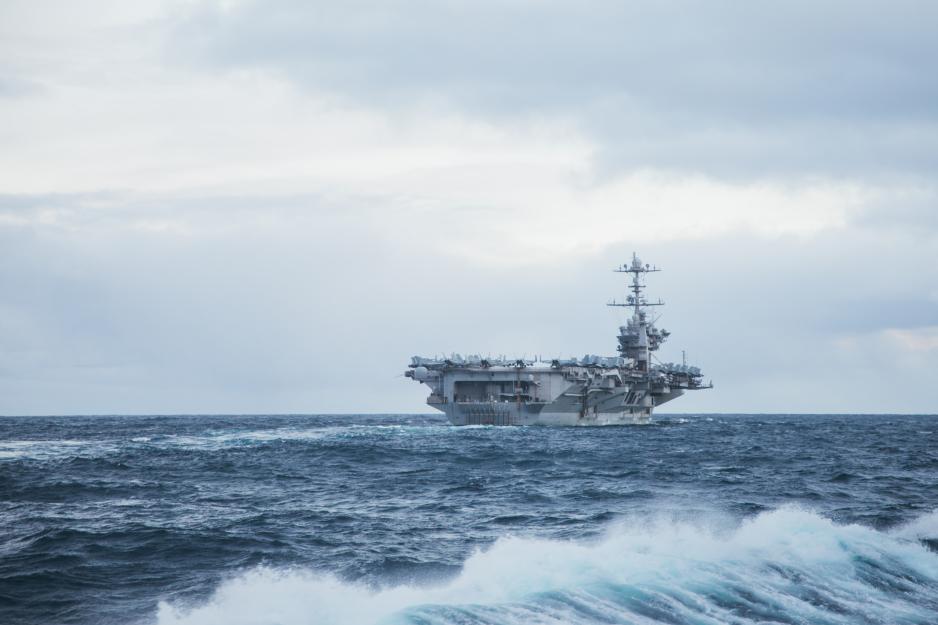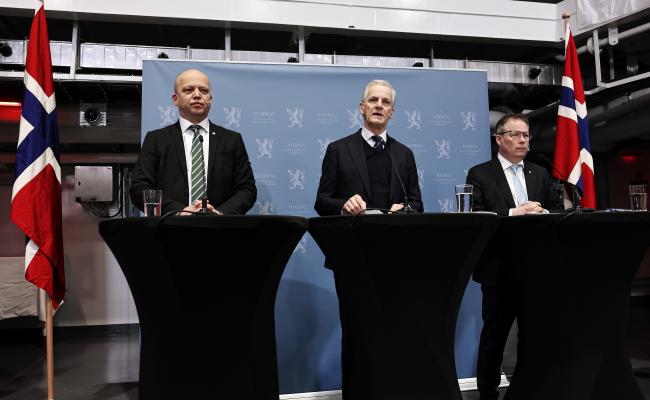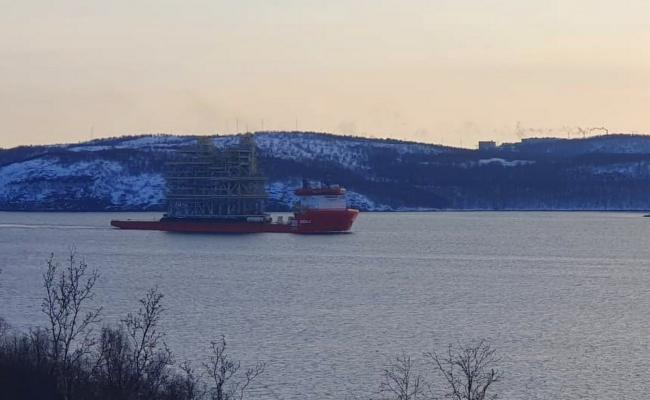Russia's Activity in the North Has Changed: "Fewer Civilian Disturbances"
Kristian Åtland, Senior Research Fellow at the Norwegian Defence Research Establishment. (Photo: Marie Staberg)
The Russian activity pattern in the North has changed since February 24th, 2022, believes a Senior Research Fellow at the Norwegian Defence Research Establishment.
Over the past years, Russian firing exercises have expanded. At the same time, there is a change in where Russia exercises.
Senior Research Fellow at the Norwegian Defence Research Establishment (FFI), Kristian Åtland, has cooperated with Editor of the Barents Observer, Thomas Nilsen, and Professor at Nord University, Torbjørn Pedersen.
Together, they have mapped Russia's military exercise activity off the Norwegian coast from 2015 to 2023. The data comes from open sources, the main source of which has been Russian "Notices To Airmen" (NOTAM).
"The notices contain detailed information about time and place for activities that could entail a possible risk to air and ship traffic, like a firing exercise in or above international waters."
That is stated by Kristian Åtland, Senior Research Fellow at the FFI and professor in political science at Nord University.
The motivation for our study is to map trends in Russian activity.
In the years before Russia's full-scale attack on Ukraine on February 24th, 2022, the Russian military exercises at sea and in the air occasionally took place in the Norwegian Sea, close to, and along the Norwegian coast, according to the study.
Some of the firing exercises took place as far south as the Vestland coast. In February 2022, however, there was a shift in the center of gravity.
Desired development
From February 2022 to December 2023, the Russians have moved most of their military activity northward, to the Barents Sea.

USS Harry Truman during the Trident Juncture 2018 exercise. (Photo: Odd Linnea Brekke Iden / the Norwegian Armed Forces)
"Symbolic demonstrations of strength far south in the Norwegian Sea, as we saw during the Trident Juncture exercise in 2018, have mainly ceased. Since February 24th, 2022, there has not been a single Russian NOTAM incident in the Norwegian Sea south of the Arctic Circle."
Åtland believes it is positive, seen from the Norwegian side, that the Russian Northern Fleet conducts most of its firing exercises in their own vicinity.
"It will affect civilian activity off the Norwegian coast to a lesser degree, whether that is fisheries or civil ship and air traffic."
There are fewer disturbances for the fisheries and civilian ship and air traffic now.
"The problem for the civilian activity has been having to sail around closed-off areas, which could entail extra costs in terms of fuel."
Åtland emphasizes that this is completely legal activity according to international law.
"Everything happening outside Norwegian territorial waters, i.e., more than 12 nautical miles from the coast, is essentially completely legal."
"It is desirable that Russia considers and minimizes disturbance of civilian infrastructure and civilian activity when choosing where to conduct these firing exercises."
According to Åtland, Norway should surveil the Russian military activity happening close to Norwegian waters and airspace.
Also read
More extensive and longer firing ranges
Although military activity has moved from the Norwegian Sea to the Barents Sea, outside the coast of the Kola Peninsula, the firing ranges have changed.
The firing ranges have become larger and longer.
"A clear trend is that the firing ranges have become more extensive in the past two-year period than in the years before 2022. Several large Russian firing ranges in the Barents Sea are partly in the Russian economic zone and partly in the Norwegian. At the same time, the firing ranges last longer on average."
The longest firing range registered was 11 days, according to Åtland.
The researchers have also explored whether the firing ranges coincide in time and space with NATO exercises in Norwegian waters.
"The Russians established a firing range on top of a Trident Juncture exercise area. It was clearly politically motivated."
The aim was to put a spanner in the works of the NATO exercise.
Examples of similar behavior from the Russian side have been observed in connection with American forces visiting Norway, as well as other NATO exercises, according to Åtland.
"For example, we saw it during the Cold Response exercise in March 2022. The day after the opening of the exercise, the Russians announced a firing range in the Norwegian Sea. However, this was small in extent and relatively short-lasting – three days – and was located far from the coast, about midway between Northern Norway and Iceland."

Dutch soldiers practice landing in Mid Troms during Cold Response 2022. (Photo: Torgeir Haugaard / the Norwegian Armed Forces)
Did not act provocatively
In March, over 20,000 soldiers from 13 countries participated in the major NATO exercise Nordic Response. The military exercise occurred across northern Norway, Finland, and Sweden.
Much of the activity took place as far east as the Alta area.
The researchers behind the study were curious to see how the Russian military would react to the Nordic Response exercise.
"Our impression is that Russia has not acted particularly provocatively in connection with this exercise. They had many vessels and aircraft out to surveil the exercise. That is normal and expected behavior from the Russian side."
"However, there were no registered NOTAM incidents off the Norwegian coast during the exercise."
According to Åtland, it is difficult to determine what the identified changes in Russia's military activity pattern are due to. In an attempt to explain the trends, the researchers have drawn up five hypotheses.
Five hypotheses explaining Russia's military activity pattern
Hypothesis 1: The Russians may have realized that their former "signaling activity" in the Norwegian Sea may not have had the intended/desired result.
"Previously, the Russians have had symbolic demonstrations far south in the Norwegian Sea, the purpose of which is basically to make Norway reduce the number of major exercises in the North, but it has had the opposite effect. The NATO exercises have evolved and are happening further north than before," Åtland points out.
Hypothesis 2: Increased "pushback" from civilian actors and other countries' authorities
"Civilian actors and foreign governments have resisted and protested the activity. On some occasions, the fisheries have refused to move when Russia has announced exercises, among other things."
Hypothesis 3: Reduced conventional capacity after Russia's full-scale invasion of Ukraine
Åtland believes the shift in gravity may be explained as a capacity issue.
"The number of available aircraft and vessels are lower than before or by extension: they want to save ammunition and rockets to use them in the Ukraine war, rather than exercises in the Norwegian Sea and the Barents Sea.
Hypothesis 4: Increased Russian focus on nuclear deterrence and the need to strengthen the bastion defense in the Barents Sea
"There is a lot of focus on the bastion defense in the Barents Sea and the need to protect the patrol areas of the strategic submarines there. That could be part of the explanation."
Hypothesis 5: Transition from "small-scale" signaling in domestic/coastal waters
Russia saves fuel by practicing in its own immediate areas instead of sailing down along the Vestland coast.
"This is a quite new development that we have not seen before. We first observed it last summer at a firing range far into Russsian territorial waters in the Varangerfjord area. Whether this will be a new trend remains to be seen."
Åtland believes hypotheses three and four are most likely.
"I believe this with nuclear weapons to be both relevant and important. On the Russian side, there is currently a lot of nuclear deterrence. They are very concerned with it. I believe that this is an important part of explaining the behavior change in the past two years and the increased focus on the Barents Sea."
"At the same time, we must remember that several of the Northern Fleet's vessels have been or are in the Mediterranean Sea or the Black Sea on missions related to the war in Ukraine. As long as they are there, there will be a reduced capacity in the North."
Now what?
"Right now, there is little indication that Russia is resuming these demonstrations of strength off the Vestland coast, far south in the Norwegian Sea, but we cannot rule it out long-term, of course."
According to Åtland, the path forward will depend on how Russia's relationship with NATO develops, as well as how Sweden and Finland's NATO membership will change the security policy landscape in Northern Europe.
In addition, the development of the war in Ukraine will affect Russia's military activity in the North, believes Åtland.
"Russia will likely attempt to strengthen its military presence in other regions, such as by the border to Finland. This is a new situation in the sense that NATO's border against Russia has doubled in length. It is a worry for Russia, which will likely attempt to strengthen its military presence on the eastern side of this border in the republic of Karelia and Kalingrad by the Baltic Sea.






